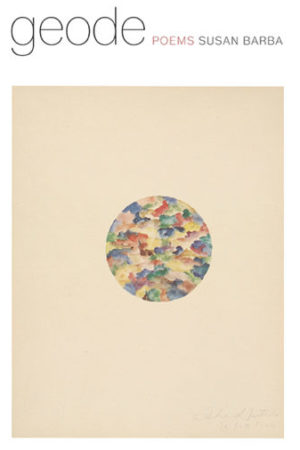geode
by Susan Barba
reviewed by Nadia Colburn
How do we write poems at this moment, when we’re aware of the urgency of the climate crisis? And how, without a tone of panic, do we add something to the discourse that isn’t communicated in other forms? Susan Barba’s second book, geode, is an original and impressive response to this challenge.
The book takes as its epigraph the equation of a sphere: x² + y² + z² = 1. A mathematical formula, of course, is a translation of the three-dimensional world into human language. This is also the project of the book: to explore the ways in which the human translates–for better and for worse–the world around us, and to reimagine those possibilities.
geode opens with a beautiful, psalm-like small poem, “(song)”:
now
is the heat of the day
now is the heat of the day
where is the garden the garden of my lord
where he walked in the cool
of the day
The beauty, longing, and spiritual presence of this short lyric poem introduce us to the book through the heart. But Barba quickly shifts away from the lyric, and takes us to a series of “Exhibit” poems of the earth itself, leading us finally to Walter De Maria’s The New York Earth Room: a gallery in SoHo, filled with 127,000 kilograms of earth.
Barba places into a communal space her treatment of how to live and make art in the Anthropocene, and the questions she asks are not individual but collective: “Aren’t we colonizing time,” the multi-part poem “Ore” asks. In the next section of the same poem, Barba writes:
in the multi-volume registers
of rock
H. sapiens is the latest
one-line entrybut the mineral
alphabet does not begin
with
anthropos
The book is mistrustful of a human-centered vision–after all, this vision is responsible for the destruction we wreak on the world around us, threatening to make our own era a mere blip in geological time.
The poem I find most compelling is the long “River,” in the middle of the book: inspired by a 2017 case that asked a Colorado court to grant the Colorado River personhood, the poem is a history and philosophy lesson, and a plea to reconsider how humans treat the world around us. It blends close, lyrical description with legal language to make the case for the river as a person.
It is by virtue of this immense life-
giving labor
that the river is not a rights-holder
but a natural object,
meant for profit,
like slaves like women …
…this simile in a first-year property casebook
(c) 1968, now in its fourth edition:“after all, land, like woman,
was meant to be possessed.”
The poem reminds us that how we treat the land is not, in fact, different from how we treat people, that women and slaves have also been treated as possessions; it reminds us elsewhere that Agent Orange, a deathly toxic substance, is used over the land and over civilians, while corporations have been granted the legal status of personhood. At the end of the poem, after multiple appeals, the case is thrown out of court.
But if the court refuses to hear the case, readers do not. The poem reminds us of what it means to treat the world around us as subject, not object, and what it means to be in right relation to the earth and to one another. I don’t read poetry to necessarily learn something new, but rather to feel differently, and “River”— like geode overall—succeeds in making me reorient myself in relation to the world around me, and feel more deeply.
It is because the book provides a larger perspective that the beauty of the river and its meaning are all the more poignant. Similar descriptions of the rich life on earth are moving: we see the poet making coffee, a “dapple throat nightingale,” a “metallic blue” Lincoln. The few poems in which the poet shows her children are, like the book, tender, clear-sighted, full of love, but not sentimental. In “Letter from Gaia,” the earth itself speaks as a mother figure, weary of her troublesome children, but still caring.
As a reader, I sometimes wanted more of the lyric voice, more of the particular, more of the human. But that’s exactly the point of the book: an orchestration of this longing. Always in tension between the human and non-human, geode reminds us, even in what it leaves out, of how small, how vulnerable, and also how precious we are, in a vast world and in the vast stretches of time.
A mathematical equation expresses a relationship; if this relationship is out of kilter, then the whole structure might fall apart. That is where we stand today. The final poem, “Letter from Stone,” leaves us, again, with a timescale and perspective that stretch beyond the destruction not only of the human but of organic life as we know it: “maybe it is a kind of eternity / the earth’s.” The vision, while stark, is not completely dark, because it carries a spaciousness, full of respect, and a tender but urgent plea to value this beautiful world we inhabit.
If only more people had the respect that Barba brings to the world around her and to every word on the page, we’d be a much healthier species—and have a much healthier planet.
Published on March 15, 2021

